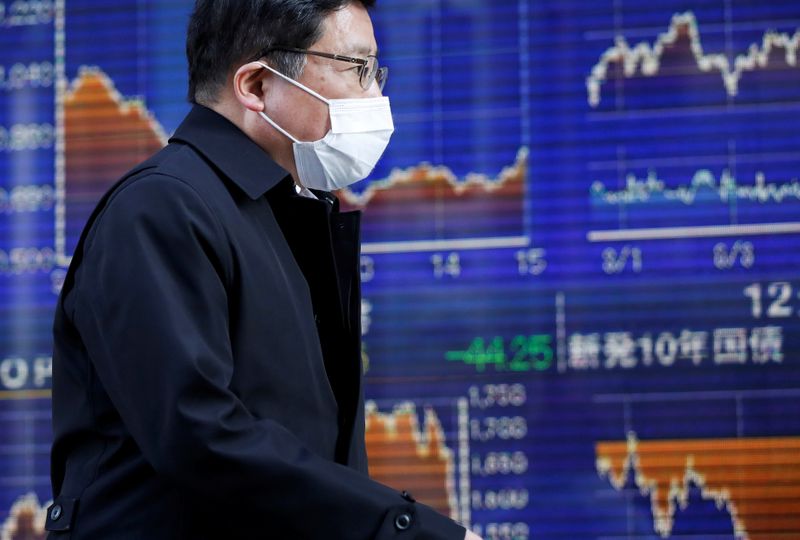By Karin Strohecker and Hideyuki Sano
LONDON/TOKYO (Reuters) - Global stocks stumbled back into the red on Wednesday with Wall Street futures pointing to more losses ahead as fears over the coronavirus fallout eclipsed large-scale support measures rolled out by policymakers around the globe.
Some traditional safe-haven assets such as gold were also under pressure as battered investors looked to unwind their damaged positions.
Oil prices fell for a third session with U.S. crude futures tumbling to a 17-year low.
"Another remarkable day in what is clearly fin-de-regime," Rabobank's global strategist Michael Every wrote in a note.
"Things have already irrevocably changed and whipsaw market action reflects that this is the case. The only issue is how much further they change from here, and hence where markets settle."
European equity markets suffered hefty losses with London and Frankfurt down 3.5% in early trade while Paris and Milan slipped around 3%.
The falls in Europe followed losses in Asia where MSCI's broadest index of Asia-Pacific shares outside Japan dropped 3.8% to lows last seen in summer 2016, led by a 6.4% fall in Australia. Japan's Nikkei erased early gains to dip 1.7%. MSCI's global stocks index dropped 1%.
Losses were set to extend to Wall Street with U.S. stock futures indicating as much as 4% lower and hitting their daily low limit just a day after the S&P 500 rose 6% and Dow Jones rose 5.2% or 1,049 points. (N)
"A rise of 1,000 points in Dow is something you see only during a financial crisis. It is not a good sign," said Tomoaki Shishido, senior fixed income strategist at Nomura Securities.
"A rise of 100 points would be much better for the economy."
Big price swings have left market participants nursing losses, making them reluctant to jump back into the market and thereby reducing trading volume.
Tuesday's Wall Street gains came as policymakers cobbled together packages to counter the impact of the virus.
The Trump administration unveiled a $1 trillion stimulus package that could deliver $1,000 cheques to Americans within two weeks to buttress a virus-stricken economy.
Britain launched a 330 billion pounds ($400 billion) rescue package for businesses threatened with collapse while France, which went into lockdown on Tuesday, is to pump 45 billion euros ($50 billion) of crisis measures into its economy to help companies and workers.
Still, forecasters at banks are projecting a steep economic contraction in at least the second quarter as governments take draconian measures to combat the virus, shutting restaurants, closing schools and calling on people to stay home.
Tuesday saw also the U.S. Federal Reserve step in again to ease funding stress among corporates by reopening its Commercial Paper Funding Facility to underwrite short-term corporate loans.
"While markets react to positive news on stimulus, that doesn't last long. I think there are a lot of banks and investors whose balance sheet was badly hit and they still have lots of positions to sell," said Shin-ichiro Kadota, senior currency and rates strategist at Barclays (LON:BARC).
CORONA BONDS
In Europe, speculation grew around the issuance of joint euro zone "coronavirus" bonds or a European guarantee fund to help member states finance urgent health and economic policies.
That lifted high-grade euro zone government bonds yield, led by Germany, where yields rose nine basis points to the highest level in over a month at -0.342%. [GVD/EU]
Italian government bonds gained some respite after several sessions of relentless selling, with yields falling between two and six basis points across the curve.
Benchmark U.S. 10-year Treasury yield edged up to a fresh three week high of 1.2080 after the Fed move eased some market jitters, while U.S. 30-year bond yields climbed as high as 1.8380%.
In currency markets, the safe-haven yen gained sharply while the dollar held onto hefty overnight gains against other currencies. [FRX/]
The dollar slipped 0.1% against the yen to 107.53 yen while the euro stood at $1.0971. The dollar index against a basket of currencies stood at 99.699, up 0.12% on the day.
Oil prices fell as the outlook for fuel demand darkened with travel and social lockdowns triggered by the coronavirus epidemic.

U.S. crude was down 84 cents, or 3.12%, at $26.11 a barrel by 0822 GMT, having earlier fallen to $25.83 a barrel, the lowest since May 2003. [O/R]